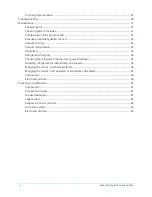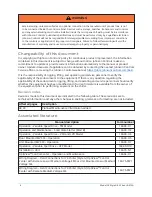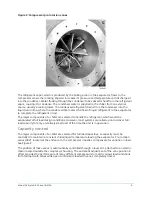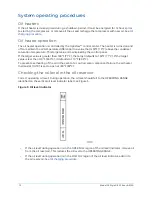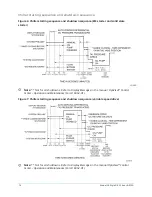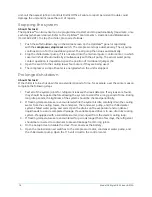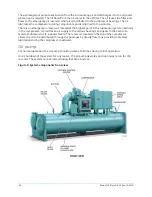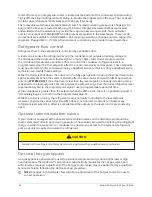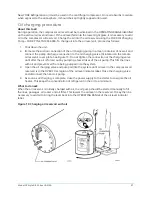
For display messages and information pertaining to the operation, refer to
OptiView™ Control Center
– Operation and Maintenance (Form 160.54-O1)
.
Note:
Any malfunctions which occur during STOP/RESET are also displayed.
Chiller operation
The unit capacity varies to maintain the leaving
Chilled Liquid Temperature
setpoint by the
pre-rotation vanes, which are modulated by an actuator under the control of the microprocessor
board. The vane control routine employs proportional plus derivative (rate) control action. A drop
in chilled liquid temperature causes the actuator to close the pre-rotation vanes to decrease chiller
capacity. When the chilled liquid temperature rises, the actuator opens the pre-rotation vanes to
increase the capacity of the chiller.
However, the current draw (amperes) by the compressor motor is also limited to FLA setpoint by
the microprocessor.
If the load continues to decrease, after the pre-rotation vanes are entirely closed, the chiller will be
shut down by the
Leaving Chilled Liquid – Low Temperature Control
.
The coolant temperature inside any JCI-supplied liquid-cooled motor starter must be maintained
above the dewpoint temperature in the equipment room to prevent condensing water vapor
inside the starter cabinet. An additional temperature-controlled throttle valve is needed in the flow
path for the starter heat exchanger, to regulate cooling above the equipment room dewpoint for
applications using cooling sources other than evaporative air-exchange methods, such as wells,
bodies of water, and chilled water. The temperature control valve should be the type to open on
increasing drive coolant temperature, fail-closed, and set for a temperature above dewpoint. It can
be requested as factory- supplied on a chiller order by special quotation.
Condenser water temperature control
The YORK chiller is designed to use less power by taking advantage of lower than design
temperatures that are naturally produced by cooling towers throughout the operating year. Exact
control of condenser water, such as a cooling tower bypass, is not necessary for most installations.
The minimum entering condenser water temperature for full and part load conditions is specified
in the chiller engineering guide.
Where:
ECWT = Entering Condensing Water Temperature
LCWT = Leaving Chilled Water Temperature
C Range = Condensing water temperature range at the given load condition.
At start-up, the entering condenser water temperature can be as much as 25°F (14°C) colder
than the standby return chilled water temperature. Cooling tower fan cycling normally provides
adequate control of the entering condenser water temperature on most installations.
Heat recovery chillers and chillers using optional head pressure control would use a signal provided
by the microprocessor to control main condenser bundle heat rejection or pressure, respectively.
Operating log sheet
Keep a permanent daily record of system operating conditions (temperatures and pressures)
recorded at regular intervals throughout each 24 hour operating period.
15
Model YK Style G R-134a or R-513A




